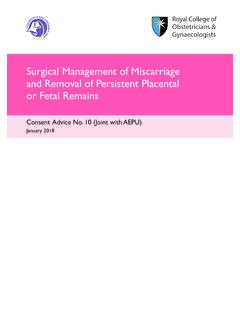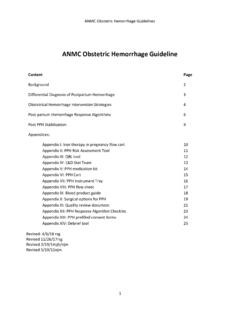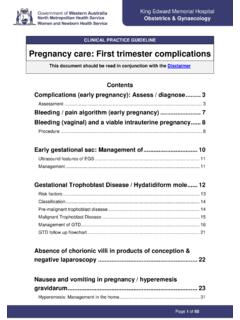Transcription of ACOG PRACTICE BULLETIN - Clinical Innovations
1 acog P RACTICE BULLET IN. Clinical management Guidelines for Obstetrician Gynecologists Number 183, October 2017 (Replaces PRACTICE BULLETIN Number 76, October 2006). Committee on PRACTICE Bulletins Obstetrics. This PRACTICE BULLETIN was developed by the American College of Obstetricians and Gynecologists'. Committee on PRACTICE Bulletins Obstetrics in collaboration with Laurence E. Shields, MD; Dena Goffman, MD; and Aaron B. Caughey, MD, PhD. Postpartum Hemorrhage Maternal hemorrhage, defined as a cumulative blood loss of greater than or equal to 1,000 mL or blood loss accom- panied by signs or symptoms of hypovolemia within 24 hours after the birth process, remains the leading cause of maternal mortality worldwide (1). Additional important secondary sequelae from hemorrhage exist and include adult respiratory distress syndrome, shock, disseminated intravascular coagulation, acute renal failure, loss of fertility, and pituitary necrosis (Sheehan syndrome).
2 Hemorrhage that leads to blood transfusion is the leading cause of severe maternal morbidity in the United States closely followed by disseminated intravascular coagulation (2). In the United States, the rate of postpartum hemor- rhage increased 26% between 1994 and 2006 primarily because of increased rates of atony (3). In contrast, maternal mortality from postpartum obstetric hemorrhage has decreased since the late 1980s and accounted for slightly more than 10% of maternal mortalities (approximately deaths per 100,000 live births) in 2009 (2, 4). This observed decrease in mortality is associated with increasing rates of transfusion and peripartum hysterectomy (2 4). The purpose of this PRACTICE BULLETIN is to discuss the risk factors for postpartum hemorrhage as well as its evalu- ation, prevention, and management .
3 In addition, this document will encourage obstetrician gynecologists and other obstetric care providers to play key roles in implementing standardized bundles of care (eg, policies, guidelines, and algorithms) for the management of postpartum hemorrhage. Background increased blood deficit. Although visually estimated blood loss is considered inaccurate, use of an educa- The American College of Obstetricians and Gynecolo- tional process, with limited instruction on estimating gists' ( acog ) reVITALize program defines postpartum blood loss, has been shown to improve the accuracy of hemorrhage as cumulative blood loss greater than or such estimates (7). Historically, a decrease in hematocrit equal to 1,000 mL or blood loss accompanied by signs of 10% had been proposed as an alternative marker to or symptoms of hypovolemia within 24 hours after the define postpartum hemorrhage; however, determinations birth process (includes intrapartum loss) regardless of of hemoglobin or hematocrit concentrations are often route of delivery (5).
4 This is in contrast to the more delayed, may not reflect current hematologic status, and traditional definitions of postpartum hemorrhage as an are not clinically useful in the setting of acute postpartum estimated blood loss in excess of 500 mL after a vaginal hemorrhage (8). birth or a loss of greater than 1,000 mL after a cesarean In postpartum women, it is important to recognize birth (6). This new classification is likely to reduce the that the signs or symptoms of considerable blood loss number of individuals labeled with postpartum hemor- (eg, tachycardia and hypotension) often do not present or rhage. However, despite this new characterization, a do not present until blood loss is substantial (9). There- blood loss greater than 500 mL in a vaginal delivery fore, in a patient with tachycardia and hypotension, the should be considered abnormal and should serve as an obstetrician gynecologist or other obstetric care provider indication for the health care provider to investigate the should be concerned that considerable blood loss, usually e168 VOL.
5 130, NO. 4, OCTOBER 2017 OBSTETRICS & GYNECOLOGY. representing 25% of the woman's total blood volume uterine massage, bimanual compression, and uterotonic (or approximately 1,500 mL or more), has occurred (10). drugs (15). Maternal trauma is indicated by lacerations, Thus, earlier recognition of postpartum hemorrhage (eg, expanding hematomas, or uterine rupture. Retention of before deterioration in vital signs) should be the goal in placental tissue can be readily diagnosed with manual order to improve outcomes. examination or bedside ultrasonography of the uterine cavity and is addressed with manual removal or uter- Differential Diagnosis ine curettage. Thrombin is a reminder to evaluate the The initial management of any patient with obstetric patient's coagulation status and if abnormal to correct hemorrhage requires that the obstetrician gynecologist with replacement of clotting factors, fibrinogen, or other or other obstetric care provider first identify the source factor replacement sources (see sections on Transfusion of bleeding ( uterine , cervical, vaginal, periurethral, peri- Therapy and Massive Transfusion).)
6 It is important to clitoral, perineal, perianal, or rectal). This can be quickly identify the most likely diagnosis or diagnoses to ini- done with a careful physical examination. After the tiate appropriate interventions. These diagnoses are anatomic site is identified, it is important to identify the outlined individually in the Clinical Considerations and cause because treatment may vary. The most common Recommendations section. etiologies (see Box 1) are broken into primary or sec- ondary causes. Primary postpartum hemorrhage occurs Risk Factors within the first 24 hours of birth, whereas secondary Because obstetric hemorrhage is unpredictable, relatively postpartum hemorrhage is defined as excessive bleeding common, and leads to severe morbidity and mortality, all that occurs more than 24 hours after delivery and up to obstetric unit members, including the physicians, mid- 12 weeks postpartum (11, 12).
7 Wives, and nurses who provide obstetric care, should be When evaluating a patient who is bleeding , it may be prepared to manage women who experience it. A number helpful to consider the 4 Ts mnemonic device tone, of well-established risk factors such as prolonged labor trauma, tissue, and thrombin (13). Abnormal uterine or chorioamnionitis are associated with postpartum hem- tone ( uterine atony) is estimated to cause 70 80% of orrhage (Table 1). However, many women without these postpartum hemorrhage and usually should be suspected risk factors can experience a postpartum hemorrhage first as the etiology of postpartum hemorrhage (14). (16). State and national organizations have suggested Recommended interventions for uterine atony include that a maternal risk assessment should be conducted antenatally and at the time of admission and continuously modified as other risk factors develop during labor or the postpartum period (17).
8 Box 1. Etiology of Postpartum Hemorrhage ^ Risk assessment tools are readily available (18, 19). Primary: and have been shown to identify 60 85% of patients who will experience a significant obstetric hemorrhage uterine atony (17, 20, 21). An example of this type of assessment Lacerations tool is outlined in Table 2. However, a validation study Retained placenta of this tool among a retrospective cohort of more than Abnormally adherent placenta (accreta) 10,000 women showed that although the tool correctly identified more than 80% of patients with severe post- Defects of coagulation (eg, disseminated intravascular coagulation)* partum hemorrhage, more than 40% of women who did not experience hemorrhage were placed into the high- uterine inversion risk group giving the tool a specificity of just below Secondary: 60% (20).
9 Additionally, approximately 1% of women in the low-risk group experienced a severe postpartum Subinvolution of the placental site hemorrhage, which indicates that the Clinical value for Retained products of conception identifying patients through risk assessment is low. Infection These findings reinforce the need for diligent surveil- Inherited coagulation defects (eg, factor deficiency lance in all patients, including those initially thought to such as von Willebrand) be at low risk. *These include inherited coagulation defects as well as acute Prevention coagulopathies that may develop from events such as amniotic fluid embolism, placental abruption, or severe preeclampsia. Many organizations have recommended active manage- ment of the third stage of labor as a method to reduce VOL.
10 130, NO. 4, OCTOBER 2017 PRACTICE BULLETIN Postpartum Hemorrhage e169. the incidence of postpartum hemorrhage (22 24). The effective medication with the fewest adverse effects (26). three components of active management are as follows: Oxytocin plus methylergonovine or oxytocin in combi- 1) oxytocin administration, 2) uterine massage, and 3) nation with misoprostol appears to be no more effective umbilical cord traction (25). Prophylactic oxytocin, by than oxytocin used alone for prophylaxis (26, 27). The dilute intravenous infusion (bolus dose of 10 units), or timing of oxytocin administration after delayed umbili- intramuscular injection (10 units), remains the most cal cord clamping, with delivery of the anterior shoulder, Table 1. Antenatal and Intrapartum Risk Factors for Postpartum Hemorrhage^.






